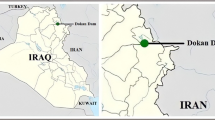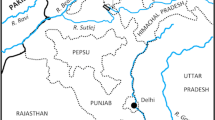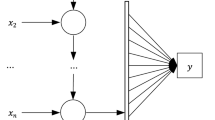Abstract
Climate change is a long-term change in the ordinary weather conditions that affects the local, regional and global climates. One of the response solutions to overcome this phenomenon is by managing water resources more efficiently. The reservoir is a major infrastructure to achieve water resource management and therefore it requires accurate water resources forecasting. The SVR and MLPNN models are introduced as a solution to achieve an efficient reservoir inflow forecasting. There are many input parameters that influence reservoir water flow but the 3 most important parameters are storage level, rainfall, and evaporation that need to be fed into the two models. There have been various model parameters tested such as kernel types in the SVR and the number of hidden layers and neurons in the MLPNN. Both models have proven their ability but however, the MLPNN with two hidden layers and 4 neurons in each layer had outperformed the SVR after being tested using four different performance tests.
Access this chapter
Tax calculation will be finalised at checkout
Purchases are for personal use only
Similar content being viewed by others
References
Bryson B, Zbigniew WK, Jean P (2008) Technical paper of the intergovernmental panel on climate change. IPCC Secretariat, Geneva, Intergovernmental Panel on Climate Change, pp 210. ISBN: 978-92-9169-123-4
Liu J, Yang H, Gosling SN et al (2017) Water scarcity assessments in the past, present, and future. Earth’s Futur 5:545–559. https://doi.org/10.1002/2016EF000518
Valizadeh N, El-Shafie A, Mirzaei M et al (2014) Accuracy enhancement for forecasting water levels of reservoirs and river streams using a multiple-input-pattern fuzzification approach. Sci World J. https://doi.org/10.1155/2014/432976
Dibie Chidubem Damian (2019) A critical review on artificial intelligence models in hydrological forecasting how reliable are artificial intelligence models. Int J Eng Res V8. https://doi.org/10.17577/IJERTV8IS070123
Choong SM, El-Shafie A (2014) State-of-the-art for modelling reservoir inflows and management optimization. Water Resour Manag 29:1267–1282. https://doi.org/10.1007/s11269-014-0872-z
Drucker H, Surges CJC, Kaufman L et al (1997) Support vector regression machines. Adv Neural Inf Process Syst 1:155–161
Noori R, Karbassi AR, Moghaddamnia A et al (2011) Assessment of input variables determination on the SVM model performance using PCA, gamma test, and forward selection techniques for monthly stream flow prediction. J Hydrol 401:177–189. https://doi.org/10.1016/j.jhydrol.2011.02.021
Yang T, Asanjan AA, Welles E et al (2017) Developing reservoir monthly inflow forecasts using artificial intelligence and climate phenomenon information. Water Resour Res 53:2786–2812. https://doi.org/10.1002/2017WR020482
Reilly DL, Cooper LN (1995) An overview of neural networks: early models to real world systems. 300–321. https://doi.org/10.1142/9789812795885_0023
Eskandarin A, Nazarpour H, Teimouri M, Ahmadi MZ (2010) Comparison of neural network and K-nearest neighbor methods in daily flow forecasting. J Appl Sci 10:1006–1010
Allawi MF, Jaafar O, Mohamad Hamzah F, El-Shafie A (2019) Novel reservoir system simulation procedure for gap minimization between water supply and demand. J Clean Prod 206:928–943. https://doi.org/10.1016/j.jclepro.2018.09.237
Zhang X, Yu X, Qin H (2016) Optimal operation of multi-reservoir hydropower systems using enhanced comprehensive learning particle swarm optimization. J Hydro-Environment Res 10:50–63. https://doi.org/10.1016/j.jher.2015.06.003
Zhang D, Lin J, Wang D et al (2018) Modeling and simulating of reservoir operation using the artificial neural network, support vector regression, deep learning algorithm. J Hydrol 565:720–736. https://doi.org/10.1016/j.jhydrol.2018.08.050
May DB, Sivakumar M (2009) Prediction of urban stormwater quality using artificial neural networks. Environ Model Softw 24:296–302. https://doi.org/10.1016/j.envsoft.2008.07.004
Author information
Authors and Affiliations
Corresponding author
Editor information
Editors and Affiliations
Rights and permissions
Copyright information
© 2022 The Author(s), under exclusive license to Springer Nature Switzerland AG
About this paper
Cite this paper
Hassan, K.S.M., Huang, Y.F., Koo, C.H., Weng, T.K., Ahmed, A.N., Elshafie, A.H.K.A. (2022). Forecasting of Reservoir Inflow Using Machine Learning—Case Study: Klang Gate Dam Reservoir. In: Al-Emran, M., Al-Sharafi, M.A., Al-Kabi, M.N., Shaalan, K. (eds) Proceedings of International Conference on Emerging Technologies and Intelligent Systems. ICETIS 2021. Lecture Notes in Networks and Systems, vol 322. Springer, Cham. https://doi.org/10.1007/978-3-030-85990-9_4
Download citation
DOI: https://doi.org/10.1007/978-3-030-85990-9_4
Published:
Publisher Name: Springer, Cham
Print ISBN: 978-3-030-85989-3
Online ISBN: 978-3-030-85990-9
eBook Packages: Intelligent Technologies and RoboticsIntelligent Technologies and Robotics (R0)




